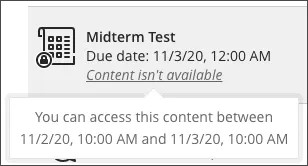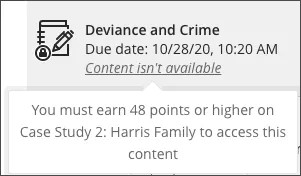Watch a video about Types of course content
The following narrated video provides a visual and auditory representation of some of the information included on this page. For a detailed description of what is portrayed in the video, open the video on YouTube, navigate to More actions, and select Open transcript.
Video: Types of Course Content
Access content in a course
At the top of the page, you can open frequently used tools. Select the icons to check the course calendar, drop in on class discussions, access your grades, and send a message. When you're finished, select the Content icon to return to all the content your instructor has made visible.
If you can access content on a future date, your instructor can show the item in the content list with that date. You can't open it, but you're alerted so you know what work is ahead.
When someone contributes to a conversation or a discussion, an activity icon appears next to the item's title on the Course Content page.
Your instructor's name and picture appear. Select the Roster to view everyone enrolled in your course. If your instructor uses the attendance feature, you can access your records from the Details & Actions panel.
You can upload files to web apps that run in the "cloud" and aren't installed on your computer, such as Google Workspace and OneDrive®.
Types of content
This table describes the types of content that your instructors can add to courses.
| Icon | Content Type | Description |
|---|---|---|
| Assignment | Instructors use assignments to assess your knowledge of course content and objectives. Your instructors often assign grades to assignments. Instructors can also create assignments for groups of students. | |
| Test | Instructors use tests to assess your knowledge. Instructors can also create tests for groups of students. | |
| Link to discussions | Instructors can provide a link to a discussion near related content. For example, you might be asked to read a file and then respond in discussions. | |
| Journal | Instructors can use journals to communicate privately with you and can grade your contributions. | |
| Document | Instructors can create a page or "handout" and add text, audio, video, files, and images. Based on the settings or what the browser allows, audio, video, and image files can appear inline. | |
| File | Select a file title to download it. | |
| SCORM | Instructors can add web-based content packages from academic publishers or instructional designers. SCORM packages open in a new window and may count for a grade. | |
| Audio | Audio files appear inline or open in new windows or tabs. You have controls to pause, play, and adjust the volume. | |
| Embedded Cloud Document | If your institution uses this feature, instructors can link a read-only Word, Excel, or PowerPoint file to your course. The content also appears in your course outline. | |
| Google Document | If your institution uses this feature, instructors can link read-only Google Docs, Sheets, or Slides to your course. The content also appears in your course outline. | |
| Google Collaborative Document | If your institution uses this feature, instructors can share Google Docs, Sheets, or Slides with you and your classmates to edit in your course. The content also appears in your course outline. | |
| Image | Images appear inline or open in new windows or tabs. | |
| Video | Video files appear in inline or open in new windows or tabs. You have controls to pause, play, and adjust the volume. | |
| Link | Select the link to go to a website or resource. | |
| Folder | A folder is a content container. Instructors can use folders and sub-folders to group related material, such as a "Week 1 Case Studies" folder inside the "Week 1 Assignments" folder. Folders make materials easier to find and reduces scrolling. | |
| Learning module | Modules let you navigate from one content item to the next without distractions or extra clicks. A learning module keeps you focused on the lesson or concept. |
What if I don't see some content?
If you can access content on a future date, your instructor can show the item in the content list with that date. You can't open it, but you're alerted so you know what work is ahead.
You may need to complete other coursework and earn a certain grade before you can access an item. Your instructor sets up access rules and can choose to show you the rule. For example, if you need to earn 80 points or more, you'll see a lock icon on the Course Content page next to the content or folder. Select the link below the item to view the access rule.
Your instructor can set up multiple access rules. You need to satisfy all access rules before you can access the content.
Ally in Learn - Student
View alternative file formats
Your institution controls which tools are available.
Each student has unique learning abilities and preferences. When your instructor provides more accessible content, each individual can choose formats that work best for them. If your institution uses Blackboard Ally, instructors can use the tool to help ensure course content is accessible to every student.
After your instructor attaches files to a course, Ally creates alternative formats of the file based on the original. For example, if the original file is a PDF, Ally creates audio, electronic braille, and ePub formats of the same content. These formats are made available with the original file so everything is in one convenient location.
The alternative formats created depend on the original file type. If you don't see an option to download alternative formats, Ally isn’t enabled for that course or the file isn't a supported content type.
Find a file in your course. Select the Alternative Formats download icon. Choose the version that is best for your needs! Select Download to save the alternative format to your device.




















